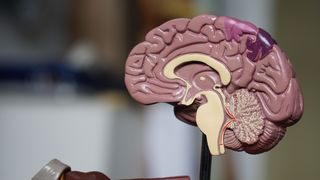Stress
5 Ways to Rewire Your Brain to Deal With Coronavirus Stress
Staying mindful and connected to loved ones can help you calm down.
Posted March 15, 2020 Reviewed by Devon Frye

The novel coronavirus epidemic has hit the world with a vengeance, creating widespread illness, fear, panic, uncertainty, and death. In many ways, it is the perfect storm of conditions to trigger automatic, primitive brain reactions to danger. It is life-threatening, invisible, unfamiliar, and unpredictable. These are all the conditions likely to stir up your brain’s threat detection system.
How Your Brain Responds to a Threat
When your brain perceives a threat, a structure called the amygdala hijacks the brain into emergency mode. The thinking centers of your brain, located in your prefrontal cortex, go partially or fully offline, and the primitive, emotional brain takes over. The primitive, emotional centers of your brain are hardwired to create a “fight, flight, or freeze” response when they perceive a threat to your survival.
Adrenaline and cortisol flood the nervous system, leading your blood pressure to rise, your breathing to get shallower, and your heart to beat faster. Your thoughts speed up, and you feel a strong urge to do something right now. Alternatively, your brain’s “freeze” response, modulated by the parasympathetic nervous system, may cause you to freeze in your tracks.
These physiological responses will serve you perfectly if you are trying to hide, run away, or defend yourself from a serial killer, but they can get in your way when you are faced with a prolonged, invisible stressor, like coronavirus. The rush of adrenaline may lead you to act impulsively without thinking, or the freeze response may keep you stuck and unable to act.
What Happens When Your Lower Brain Takes Over
We are all now familiar with the long lines in Costco, Whole Foods, and Trader Joe's as people fill up their carts with frozen food and toilet paper. Hand sanitizers and disinfecting wipes are nowhere to be found, and an atmosphere of panic and scarcity prevails. While buying some hand sanitizer and toilet paper is a good idea, hoarding excess amounts of these items may not be.
In our adrenalin-fueled attempts to protect ourselves, we may be unwittingly making our whole community (including ourselves) less safe. If only a few people have all the hand sanitizer, everybody else is less hygienically protected, and this may cause the disease to spread faster. Also, by acting impulsively, we may forget to read the CDC recommendations that only hand sanitizer with 60 percent alcohol content is effective against the virus, and that hand washing is the best way to remove the virus from your skin
What to Do
What do you do instead of panicking and letting your lower brain lead you into unwise, impulsive, or extreme actions or helplessness and despair? The five tips below will help to get your prefrontal cortex firmly back in charge so you can make well-thought-out, mindful decisions about what level of risk to assume and what actions to take.
1. Notice when you are getting triggered.
Train yourself to monitor for signs that the primitive, reactive brain has taken over and driven your thinking brain offline. You may notice physiological signs, like feeling hot and sweaty, your face getting flushed, breathing becoming shallower, or your heart beating faster. You may feel a rush of anxiety, or your thoughts may speed up. You may be stuck in a fearful way of thinking and unable to see a different perspective. You may feel panicky and want to act impulsively.
Alternatively, you may feel frozen and unable to leave your house; you may feel extreme fear at the supermarket or when interacting with other people. You may start catastrophizing about what is going to happen, believing you are definitely going to die. If you can notice these reactions early in the process, you have more ability to calm them down before they build into a cascade of panic. It may take some practice to notice them, but the more you do it, the easier it will get as new brain pathways get built.
2. Focus on your senses or your breathing.
Once you notice that you are triggered, the next thing is to stop what you are doing, take a break, and focus on taking charge of your physiology. If you are frozen, you can ground yourself by focusing on direct sensory or motor experiences. You could feel your feet on the ground and your body in the chair, stretch, walk slowly around the room, bounce a ball, describe two things that you see, suck on a mint, smell a lemon, or squeeze a stress ball. Focusing on your senses in the moment or moving around slowly helps you recover from a freeze response.
If you are in “fight or flight,” the best way to calm down is to slow down your breathing or to breathe into your belly. This activates your parasympathetic nervous system to put the brakes on autonomic nervous system arousal, and the whole system starts to calm down. Your breathing interfaces with your heart, leading your heart rate to slow down. Your brain perceives safety and sends signals throughout the system to stop producing cortisol and return to baseline.
3. Reach out to a friend or family member.
Today we are blessed with video technology that allows us to talk to friends and family in distant locations. That means that even the elderly and individuals at higher risk don’t have to be socially isolated. When you connect with a person you care about, this can calm down “fight or flight” and instead activate your brain’s social engagement system.
This is the part of your brain involved in attachment that is unique to mammals. It allows us to be soothed by the presence of other humans, through touch, tone of voice, facial expression, body language, and so on. It allows for co-regulation in which two people can soothe each other’s nervous systems. When we are with those we love, we may secrete a hormone called oxytocin, which acts as a de-stressor to the body. Cuddling with a beloved pet can also create oxytocin release.
4. Make a wise choice.
Once your nervous system returns to an emotionally regulated state and is no longer in “fight, flight, freeze,” you can think through your options and make a wise choice. Part of making a wise choice is understanding that it doesn’t have to be a perfect choice, but just what you perceive as the smartest course of action given the options and information that you have at the time. As new information emerges or the situation changes, you can adjust your behavior or make a different choice down the road.
In some situations, there may not be a really good option, and you may have to resort to the “least bad” alternative. Do you stay home and lose income or go to work at some risk to your health? Once you have made a choice, your stress hormones start to calm down, because uncertainty is reduced. When you can’t make a decision, you stress yourself out more, because your brain stays in a state of uncertainty. Our brains find uncertainty to be highly stressful.
5. Decide what level of risk you are willing to tolerate.
Your brain tends to be risk-averse because its goal is to protect you and keep you alive. Therefore, it may overestimate the amount of risk you are taking by going to the supermarket or meeting with a friend. That being said, the risk in both of these actions is greater than if you just stayed home alone and ordered home delivery.
However, if you sit home alone for months at a time, you may be risking your mental health. When we are alone, we are more likely to ruminate about catastrophic outcomes or become depressed. Depressive thinking may make you think you are the only person in the world who doesn’t have a partner or lives alone.
Research shows that loneliness is a risk factor for long-term negative health outcomes and early mortality, especially among the elderly. In summary, although there is some risk in interacting with others in the age of coronavirus, spending weeks and months isolated at home may risk your mental health. In other words, there is no choice without risk, and it is up to each of us to decide what level of physical or emotional risk we are willing to tolerate.
Summary
In summary, there are things you can do to mitigate the stress of the novel coronavirus, including noticing when you triggered into “fight, flight, freeze,” slowing down and regulating your nervous system by grounding or slow breathing, reaching out to a loved one to activate your social engagement system, making a wise (but not perfect) choice, and balancing protecting yourself with looking after your mental health.
References
Greenberg, M. (2017). The Stress-Proof Brain. Berkeley, CA: New Harbinger




